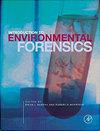用法医计量方法用同位素和物理化学测量方法表征污染源
IF 1.2
4区 环境科学与生态学
Q4 ENVIRONMENTAL SCIENCES
引用次数: 1
摘要
本文章由计算机程序翻译,如有差异,请以英文原文为准。
Characterization of a pollution source with isotopic and physicochemical measurements using a forensic metrology approach
Abstract Carbon and nitrogen composition and isotopic ratios (δ15N, δ13C, and δ13C-DIC) as well as physicochemical parameters were measured in hazardous waste leachate connected to an environmental pollution crime. A forensic metrology approach was employed by estimating the measurement uncertainty, including that from the sampling process, using range statistics. The physicochemical parameters demonstrated differences in the leachate from some of the different ponds and this was supported by carbon and nitrogen elemental and isotopic analyses. The isotopic signature of δ15N and δ13C-DIC was highly enriched in the heavy isotope demonstrating that those analyses are a substantial tool for leachate pollution tracking. The uncertainty of the measurements was below or slightly above 20% for most parameters which can be considered fit-for-purpose for a great deal of environmental surveys and was remarkably lower in the isotopic analyses. The uncertainty of measurement including the primary sampling is a relevant information in environmental investigations, especially forensic ones. This knowledge is crucial for a consistent interpretation of environmental samples analyses results, specially from polluted sites and pollution source characterization and tracking, where there is often substantial heterogeneity in environmental samples.
求助全文
通过发布文献求助,成功后即可免费获取论文全文。
去求助
来源期刊

Environmental Forensics
环境科学-环境科学
CiteScore
4.90
自引率
5.60%
发文量
23
审稿时长
3 months
期刊介绍:
Environmental Forensics provides a forum for scientific investigations that address environment contamination, its sources, and the historical reconstruction of its release into the environment. The context for investigations that form the published papers in the journal are often subjects to regulatory or legal proceedings, public scrutiny, and debate. In all contexts, rigorous scientific underpinnings guide the subject investigations.
Specifically, the journal is an international, quarterly, peer-reviewed publication offering scientific studies that explore or are relevant to the source, age, fate, transport, as well as human health and ecological effects of environmental contamination. Journal subject matter encompasses all aspects of contamination mentioned above within the environmental media of air, water, soil, sediments and biota. Data evaluation and analysis approaches are highlighted as well including multivariate statistical methods. Journal focus is on scientific and technical information, data, and critical analysis in the following areas:
-Contaminant Fingerprinting for source identification and/or age-dating, including (but not limited to) chemical, isotopic, chiral, mineralogical/microscopy techniques, DNA and tree-ring fingerprinting
-Specific Evaluative Techniques for source identification and/or age-dating including (but not limited to) historical document and aerial photography review, signature chemicals, atmospheric tracers and markets forensics, background concentration evaluations.
-Statistical Evaluation, Contaminant Modeling and Data Visualization
-Vapor Intrusion including delineating the source and background values of indoor air contamination
-Integrated Case Studies, employing environmental fate techniques
-Legal Considerations, including strategic considerations for environmental fate in litigation and arbitration, and regulatory statutes and actions
 求助内容:
求助内容: 应助结果提醒方式:
应助结果提醒方式:


